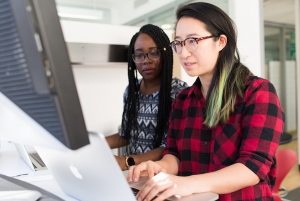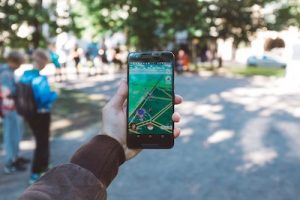The Benefits of Blended Learning in Adult Education
Educators and learners equally benefit from blended learning in adult education. In a high-quality blended learning environment, learners find increased flexibility and diversity in learning opportunities and gain a greater sense of what’s possible with technology. Educators connect to more learners where they are at, find the right mechanisms to recognize and respond to learner needs, and put innovative and responsive curriculum into practice.
Below are ways that blended learning as AlphaPlus has defined it can be of great benefit to adult educators and learners.
To reiterate our definition:
Blended learning is an approach where educators leverage technology and digital access for learners to create, communicate, collaborate and apply critical thinking skills to construct knowledge in a connected world.
1. Blended learning supports learners’ self-confidence and self-reliance.
 In a blended approach, learners use digital technology to engage in critical thinking and reflection, to be creative and exploratory, and to develop communication and problem-solving strategies. Learners build digital literacy skills, critically analyze information for relevance and trustworthiness, and build self-advocacy skills. Using technologies can change power dynamics in learning relationships between learners and educators.
In a blended approach, learners use digital technology to engage in critical thinking and reflection, to be creative and exploratory, and to develop communication and problem-solving strategies. Learners build digital literacy skills, critically analyze information for relevance and trustworthiness, and build self-advocacy skills. Using technologies can change power dynamics in learning relationships between learners and educators.
As learners and educators co-create the curriculum based on the learner’s goals and curiosity, learners start to see themselves as people who can learn and make decisions about their own learning. After being in basic education programs, many adult learners state that they experience a change in how they see themselves. Their self-identity shifts after intentionally engaging in learning. A blended learning approach increases the potential for learners to continue to practise using technology and build their literacy and language skills when they are not in literacy programs.[1] This may increase the chances of learners meeting their goals as they relate to their future employment and further education.
2. Blended learning encourages social connections and collaboration.
 Blended learning incorporates online social interactions, information-seeking, exploration, entertainment and many other reasons people use the internet into learning activities. There is collaboration both in face-to-face classroom group work and online group work. Through online social communities and connections, adult literacy learners build their networks, expand their circle of learning beyond the classroom and discover those with similar experiences around the world.[2] Learning in the digital age happens within and across networks rather than within an individual, and learners are leveraging these networks to learn, create, communicate and collaborate in all the ways available to them.[3]
Blended learning incorporates online social interactions, information-seeking, exploration, entertainment and many other reasons people use the internet into learning activities. There is collaboration both in face-to-face classroom group work and online group work. Through online social communities and connections, adult literacy learners build their networks, expand their circle of learning beyond the classroom and discover those with similar experiences around the world.[2] Learning in the digital age happens within and across networks rather than within an individual, and learners are leveraging these networks to learn, create, communicate and collaborate in all the ways available to them.[3]
3. Blended learning provides flexibilities.
 Our experience in the field with adult basic education programs has taught us that adult learners have time constraints due to work and family responsibilities and that they require flexibility in their studies. Blending online learning with classroom learning offers more choice and provides flexibilities for scheduling, setting practice times, and flipped classrooms (where learners get instructional content, usually online, before class and then focus on applying that knowledge in the classroom). It is also more responsive to the way adults learn, beyond the narrow definition of learning styles, and better reflects the complex relationship between learning processes and knowledge construction.
Our experience in the field with adult basic education programs has taught us that adult learners have time constraints due to work and family responsibilities and that they require flexibility in their studies. Blending online learning with classroom learning offers more choice and provides flexibilities for scheduling, setting practice times, and flipped classrooms (where learners get instructional content, usually online, before class and then focus on applying that knowledge in the classroom). It is also more responsive to the way adults learn, beyond the narrow definition of learning styles, and better reflects the complex relationship between learning processes and knowledge construction.
4. Blended learning helps to manage systemic inequalities.
 Addressing digital inequity is a particularly pressing issue because governments are increasingly requiring people access public services (such as healthcare, social assistance benefits and taxes) online. This will likely be experienced as a barrier to receiving services for some people. Social class, for example, is a significant factor in internet accessibility.[4] Disparities in access to an internet connection and the necessary equipment, compounded with a lack of online problem-solving skills and access to learning supports, create a double bind for vulnerable adults and exacerbate the digital divide.[5] Many adult learners are at risk of digital inequality as they already experience social and economic inequality related to age, income, education, location and immigration status.[6]
Addressing digital inequity is a particularly pressing issue because governments are increasingly requiring people access public services (such as healthcare, social assistance benefits and taxes) online. This will likely be experienced as a barrier to receiving services for some people. Social class, for example, is a significant factor in internet accessibility.[4] Disparities in access to an internet connection and the necessary equipment, compounded with a lack of online problem-solving skills and access to learning supports, create a double bind for vulnerable adults and exacerbate the digital divide.[5] Many adult learners are at risk of digital inequality as they already experience social and economic inequality related to age, income, education, location and immigration status.[6]
Blended learning can help to manage socially structured digital inequalities[7] resulting from access, literacy and connectivity barriers. It encourages self-empowerment by building digital literacy skills. Educators play a vital role in learners being able to access online public and consumer services by offering situated learning opportunities where learners build confidence navigating and evaluating online environments.[8] Building digital technology skills and knowledge helps learners manage high-stakes use of technologies (such as online interactions and form-filling tasks).
Recommendations for Blended Learning Program Development
[1] Reder, 2012.
[2] Mollins, 2011.
[3] Siemens, 2005.
[4] Greig & Hughes, 2012; Pinsent-Johnson & Sturm, 2017; Smythe & Bershears, 2017.
[5] Pinsent-Johnson & Sturm, 2017.
[6] Haight, Quan-Haase & Corbett, 2014.
[7] Greig & Hughes, 2012; Pinsent-Johnson & Sturm, 2017; Smythe & Bershears, 2017.
[8] Lave & Wenger, 1990.


Feedback/Errata